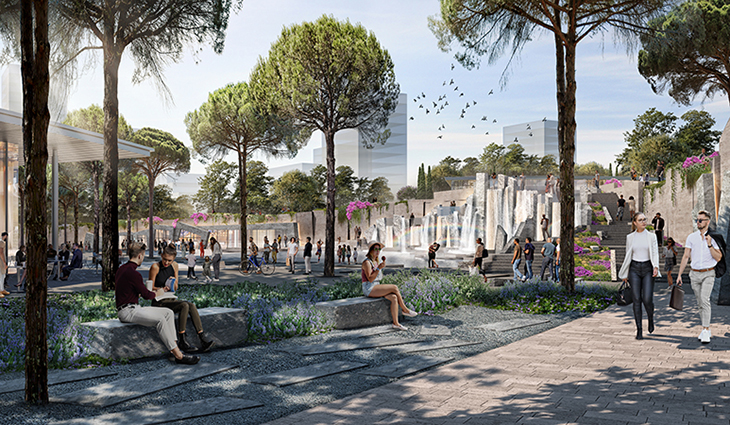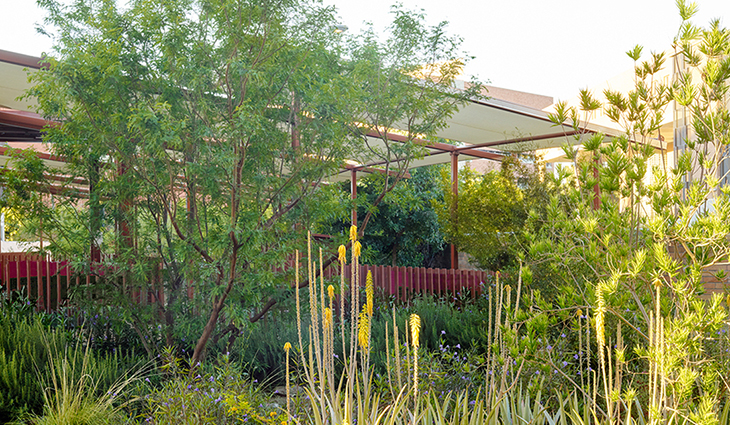At Greenbuild, Learn How to Improve Your Carbon Drawdown
9/17/2023Leave a Comment

The Kendeda Building for Innovative Sustainable Design. Atlanta, Georgia. Andropogon / Willett Photography
How can architects, developers, and planners better partner with landscape architects to achieve shared goals on greenhouse gas emission reductions and carbon drawdown? How can residential, commercial, and public landscapes be designed to advance long-term climate resilience?
To answer these questions, ASLA has organized a dynamic session — Improve Your Carbon Drawdown: Leverage Landscape Architecture Strategies to Increase Sequestration and Resilience — at the upcoming 2023 Greenbuild Conference in Washington, D.C. The live session will be on September 29 at 8.30 AM EST.
The session features landscape architecture climate leaders:
- José M. Almiñana, FASLA, Principal, Andropogon Associates, and ASLA Climate Action Plan Task Force Member
- Chris Hardy, ASLA, Senior Associate, Sasaki; Founder, Carbon Conscience; and Co-Chair, ASLA Climate Action Committee Subcommittee on Climate Drawdown and Biodiversity
- Danielle Pieranunzi, SITES Director, Green Business Certification Inc. (GBCI)
- Moderator: Katie Riddle, ASLA, Director of Professional Practice at ASLA
Landscape architects who led the creation of the ASLA Climate Action Plan and its implementation through the ASLA Climate Action Committee will outline how landscape architecture strategies, including nature-based solutions, provide significant carbon benefits and a range of economic, equity, biodiversity, public health co-benefits. They will explain the latest landscape architecture approaches that can be used to conceptualize, plan, and design projects, including Sasaki’s updated Carbon Conscience tool.
“We can only achieve carbon drawdown through the creation of diverse living systems. To protect, sustain, and regenerate complex ecological networks in harsh environments, we need to use an integrative design process. This is crucial to ensure that every design decision — regardless of which discipline made the decision — supports that goal,” Almiñana said.
“When we integrate landscape into whole-project life cycle assessments, we can take advantage of potential carbon sinks in the landscape through ecosystem preservation and restoration. We can also realize the often overlooked externalities of site infrastructure and hardscape spaces. Partnering with landscape architects early in the process can inform teams how to best leverage sites, mitigate the potential impacts of site design, and achieve greenhouse gas emission reduction goals,” Hardy said.

Ellinikon Metropolitan Park, Athens, Greece / Sasaki
Danielle Pieranunzi, director of the SITES at GBCI, will explain how certifications and guidelines, such as the SITES v2 Rating System — specifically the Pilot Credit 3: Assess and Improve Carbon Performance — and other open-source tools can lower the carbon footprint of projects.

SITES-Certified Project. ASLA 2012 Professional General Design Honor Award. Orange Mall Green Infrastructure. Tempe, Arizona. COLWELL SHELOR LANDSCAPE ARCHITECTURE / Marion Brenner
“The carbon footprint of the built environment is often understood in terms of construction, building energy use, and transportation. However, landscapes and outdoor spaces have the unique capacity to sequester carbon to help mitigate climate change. It is essential to include those with expertise in ecology and landscape architecture early — prior to design and throughout the development process — in order to achieve shared goals on greenhouse gas emission reductions and carbon drawdown. Using SITES and LEED certification ensures that such goals can be prioritized and not value engineered out,” Pieranunzi said.
Our community — the architecture, engineering, and construction industry — must transform standard practice by taking responsibility for the climate impacts of our projects — from the regional, city, to neighborhood and site scales.
The climate emergency requires both organizational and individual action to reduce emissions in all planning and design stages and prioritizing nature-based solutions in a meaningful way.


.png)
.png)
.png)
.png)
.png)
(1).png)

